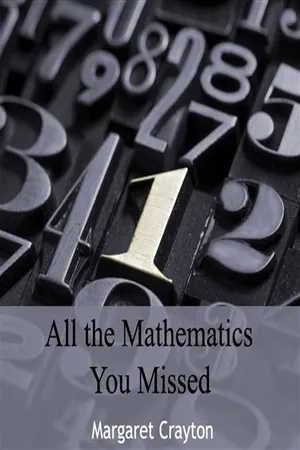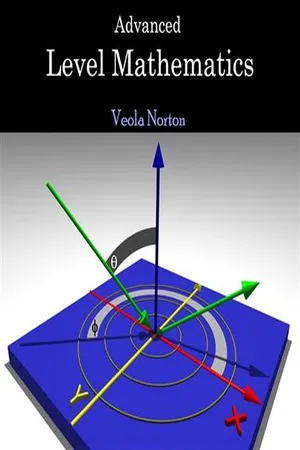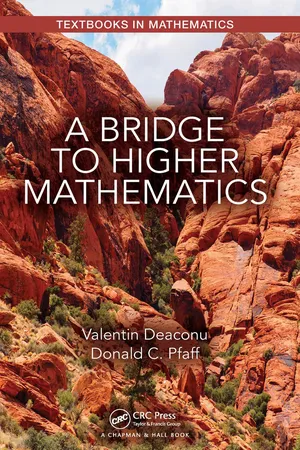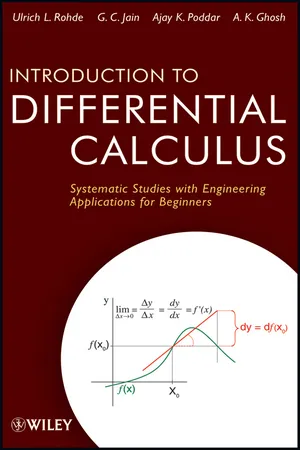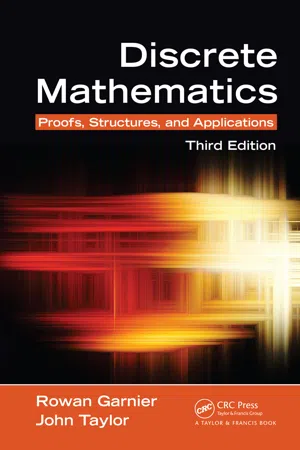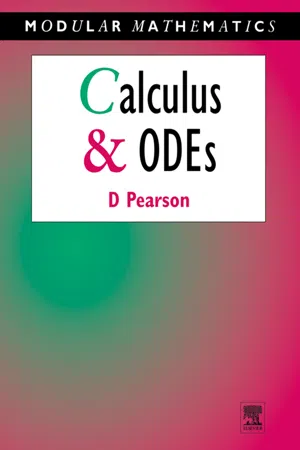Mathematics
Functions
In mathematics, a function is a relation between a set of inputs and a set of possible outputs, where each input is related to exactly one output. Functions are often represented by equations or graphs and are used to model various real-world phenomena. They are fundamental to calculus, algebra, and other branches of mathematics, providing a way to describe and analyze relationships between quantities.
Written by Perlego with AI-assistance
Related key terms
1 of 5
10 Key excerpts on "Functions"
- No longer available |Learn more
- (Author)
- 2014(Publication Date)
- Orange Apple(Publisher)
A function of two or more variables is considered in formal mathematics as having a domain consisting of ordered pairs or tuples of the argument values. For example Sum( x , y ) = x + y operating on integers is the function Sum with a domain consisting of pairs of integers. Sum then has a domain consisting of elements like (3,4), a codomain of integers, and an association between the two that can be described by a set of ordered pairs like ((3,4), 7). Evaluating Sum(3,4) then gives the value 7 associated with the pair (3,4). A family of objects indexed by a set is equivalent to a function. For example, the sequence 1, 1/2, 1/3, ..., 1/n, ... can be written as the ordered sequence <1/n> where n is a ________________________ WORLD TECHNOLOGIES ________________________ natural number, or as a function f(n) = 1/n from the set of natural numbers into the set of rational numbers. Dually, a surjective function partitions its domain into disjoint sets indexed by the codo-main. This partition is known as the kernel of the function, and the parts are called the fibers or level sets of the function at each element of the codomain. (A non-surjective function divides its domain into disjoint and possibly-empty subsets). Definition One precise definition of a function is that it consists of an ordered triple of sets, which may be written as ( X , Y , F ). X is the domain of the function, Y is the codomain, and F is a set of ordered pairs. In each of these ordered pairs ( a , b ), the first element a is from the domain, the second element b is from the codomain, and every element in the domain is the first element in one and only one ordered pair. The set of all b is known as the image of the function. Some authors use the term range to mean the image, others to mean the codomain. Th e notation ƒ: X → Y indicates that ƒ is a function with domain X and codomain Y . - No longer available |Learn more
- (Author)
- 2014(Publication Date)
- Orange Apple(Publisher)
A function of two or more variables is considered in formal mathematics as having a domain consisting of ordered pairs or tuples of the argument values. For example Sum( x , y ) = x + y operating on integers is the function Sum with a domain consisting of pairs of integers. Sum then has a domain consisting of elements like (3,4), a codomain of integers, and an association between the two that can be described by a set of ordered pairs like ((3,4), 7). Evaluating Sum(3,4) then gives the value 7 associated with the pair (3,4). A family of objects indexed by a set is equivalent to a function. For example, the sequence 1, 1/2, 1/3, ..., 1/n, ... can be written as the ordered sequence <1/n> where n is a ________________________ WORLD TECHNOLOGIES ________________________ natural number, or as a function f(n) = 1/n from the set of natural numbers into the set of rational numbers. Dually, a surjective function partitions its domain into disjoint sets indexed by the codomain. This partition is known as the kernel of the function, and the parts are called the fibers or level sets of the function at each element of the codomain. (A non-surjective function divides its domain into disjoint and possibly-empty subsets). Definition One precise definition of a function is that it consists of an ordered triple of sets, which may be written as ( X , Y , F ). X is the domain of the function, Y is the codomain, and F is a set of ordered pairs. In each of these ordered pairs ( a , b ), the first element a is from the domain, the second element b is from the codomain, and every element in the domain is the first element in one and only one ordered pair. The set of all b is known as the image of the function. Some authors use the term range to mean the image, others to mean the codomain. The notation ƒ: X → Y indicates that ƒ is a function with domain X and codomain Y . - eBook - PDF
- Valentin Deaconu, Donald C. Pfaff(Authors)
- 2016(Publication Date)
- Chapman and Hall/CRC(Publisher)
4 Functions Many times we deal with quantities which depend on other quantities: the volume depends on the size, the heat index depends on the humidity, the force depends on the mass. These illustrate the idea of a function. In mathematics, a function is a certain rule which associates to any element in a set A, called the domain, a unique element in a set B, called the codomain. You already met real Functions of real variables in calculus, like f (x) = x 2 , g(x) = ln x or h(x) = tan x. The domain and the set of values for these Functions are subsets of R, and a function is defined as a formula (or algorithm) which associates to each input in the domain a precise output. - eBook - ePub
Introduction to Differential Calculus
Systematic Studies with Engineering Applications for Beginners
- Ulrich L. Rohde, G. C. Jain, Ajay K. Poddar, A. K. Ghosh(Authors)
- 2012(Publication Date)
- Wiley(Publisher)
Chapter 2 The Concept of a Function 2.1 IntroductionThe concept of a “function” is one of the most basic in all of mathematics. The meaning of the word “function ” has evolved and changed during the last three centuries . Its modern meaning is much broader and deeper than its elementary meaning from earlier days. The statement: “y is a function of x ” means something very much like “y is related to x by some formula ”. In fact, this statement gives some idea about a function, but it is incomplete. In traditional algebra, x and y stand for numbers. But today, Functions can be defined that have nothing to do with numbers .In our study of calculus, we shall be mostly concerned with Functions, which are related to numbers. Like any other mathematical concept, the concept of function is nicely expressed through the language of sets . Therefore, it is useful to revise “Elementary Set Theory ” (see Appendix “A”).Assuming the knowledge of Elementary Set Theory, we define two important terms: (i) ordered pairs and (ii) Cartesian product of sets . These terms are needed to define a “function” on the basis of set theory. Let us discuss:i. Ordered Pairs : When we wish to consider a pair of things as a whole , we may use the terms couple or just pair . If A = {1, 2, 3, 4} then the subsets {1, 2}, {1, 3}, {1, 4}, {2, 1}, {3, 1} are some examples of pairs. Here we have listed some pairs twice ; for example {1, 2} = {2, 1} and {1, 3} = {3, 1}.We know that the order, in which the elements of a set are written, is immaterial . If in a pair we wish to single out one element as being the first, then the other element becomes the second. Once we define the procedure of fixing the position of first element (in a pair), we have example of an ordered pair - eBook - PDF
Exploring Mathematics
An Engaging Introduction to Proof
- John Meier, Derek Smith(Authors)
- 2017(Publication Date)
- Cambridge University Press(Publisher)
5 Functions In this chapter we explore the concept of a mathematical function. Undoubtedly, func- tions have been prevalent in your previous mathematical experiences. You may have spent a lot of time working with Functions given by an explicit formula, such as f (x) = x 2 sin(2x). In this chapter we develop a broader understanding of Functions, presenting a commonly used and intuitive (but incomplete) definition in Section 5.1, followed by a variety of related terminology and concepts, and then a rigorous definition in Section 5.5. 5.1. What is a Function? The notion of a function is broader than numerical Functions that are given by explicit formulas. D EFINITION 5.1 (Initial Version). Let A and B be sets. A function from A to B is a rule that assigns to each a ∈ A a unique associated element b ∈ B. There are two standard ways to represent “f is a function from A to B.” One is to write f : A → B, and the other is A f → B . Both notations are supposed to indicate that the function f takes an input element a ∈ A and outputs an element b ∈ B, and we express this by writing f (a) = b. In the sections that follow, you will often read statements like “Let f : A → B.” This is a short but complete sentence stating that f is a function from A to B. For example, consider the function g defined in a piecewise fashion for real numbers x: g(x) = −x 2 if x ≤ 0, x 4 if x > 0. The formulas −x 2 and x 4 both give real numbers if x is a real number, so we could use the notation g : R → R or R g → R because both A and B equal R. As another example, you might have encountered parametric curves which trace out patterns in the plane. One of these gives a circle parametrized by γ (t) = (sin(t), cos(t)) , as illustrated in Figure 1. Here the input is a real number t ∈ R and the output is a point (x, y) ∈ R 2 , so we write γ : R → R 2 or R γ → R 2 . 111 112 5. Functions 1 Figure 1. The image of the function γ (t) = (sin(t), cos(t)) is a circle. - eBook - PDF
- Daniel Ashlock, Colin Lee(Authors)
- 2022(Publication Date)
- Springer(Publisher)
85 C H A P T E R 7 Functions While every reader of this text is likely familiar with Functions such as a quadratic function like f .x/ D x 2 C 2x C 1, this is likely a student’s first real introduction to abstract mathematical Functions (or set theoretic Functions). In more advanced mathematics the set theoretic defini- tion of Functions is used as the default definition of a function. In this section we will define Functions and extend much of our ability to work with sets to infinite sets. There are a number of different types of Functions and so this section contains a great deal of terminology. Recall that two finite sets are the same size if they contain the same number of elements. It is possible to make this idea formal by using Functions and, once the notion is formally defined, it can be applied to infinite sets. 7.1 MATHEMATICAL Functions Definition 7.1 An ordered pair is a collection of two elements with the added property that one element comes first and one element comes second. The set containing only x and y (for x ¤ y ) is written fx; y g. The ordered pair containing x and y with x first is written .x; y/. Notice that while fx; xg is not a well-defined set, .x; x/ is a well-defined ordered pair because the two copies of x are different by virtue of coming first and second. The reason for defining ordered pairs at this point is that it permits us to make an important formal definition that pervades the rest of mathematics. Definition 7.2 A function f with domain S and range T is a set of ordered pairs .s; t/ with first element from S and second element from T that has the property that every element of S appears exactly once in some ordered pair. We write f W S ! T for such a function. We say f is a mapping of S to T , or that f maps S to T . Example 7.3 Suppose that A D fa; b; c g and B D f0; 1g then f D f.a; 0/; .b; 1/; .c; 0/g - eBook - PDF
Discrete Mathematics
Proofs, Structures and Applications, Third Edition
- Rowan Garnier, John Taylor(Authors)
- 2009(Publication Date)
- CRC Press(Publisher)
Chapter 5 Functions 5.1 Definitions and Examples In this chapter we consider another of the central concepts of modern mathematics, that of a function or mapping. Although Functions have been used in mathematics for several centuries, it is only comparatively recently that a rigorous and generally accepted definition of the concept has emerged. When historians come to write the history of mathematics in the second half of the twentieth century, the rise in importance of Functions of various kinds will almost certainly be one of their major themes. Like many of the concepts which we deal with in this book, that of a function is both simple and very general. Instead of giving the definition immediately, we shall begin with a notion with which you may very well be familiar from your previous studies—that of a (real) variable. Traditionally labelled x , a variable is often associated with expressions such as x 2 + 4 x -7 , 1 / ( x + 1) 3 , sin x, log x, etc. Expressions like these are frequently denoted f ( x ) and called ‘a function of (the variable) x ’. In such cases there is generally the assumption (which is often only implicit) that the variable x refers to an ‘arbitrary’ real number, although it may be subject to some restrictions, such as it must be positive. For us this idea of a function is both too restrictive and somewhat incomplete, although it does point towards a simpler and more general definition. The essence of the examples above is that we can calculate (in principle, at least) the value of the expression for any (allowed) value of the variable x . More important than an expression itself is the fact that it provides a ‘rule’ for calculating its value given any value of x . Two 220 Definitions and Examples 221 different expressions f ( x ) and g ( x ) may give the same values for all real numbers x , and we would regard the two expressions as defining the same function. - eBook - PDF
- David Pearson(Author)
- 1995(Publication Date)
- Butterworth-Heinemann(Publisher)
The subject matter of calculus is Functions. In fact calculus could be described as that branch of mathematics which deals with Functions and their local behaviour -we shall have more to say about that in Chapter 4. Progress in calculus must therefore be founded on a clear understanding of what Functions are, and how they can be described and used. We shall also need to agree on some of the notations which will be used throughout this book. 2.1 What is a function? The central idea of a function which you should have at the back of your mind is that of a rule, or prescription, for sending numbers to numbers. This is a good starting point, and we shall gradually refine and clarify the concept of function as we proceed. 'Numbers', here, will be taken to mean 'real numbers', rather than, say, complex numbers or rational numbers, or any of the other kinds of numbers that mathematicians have defined from time to time. It is possible to consider much more general notions of function in which we may want to consider rules for sending vectors to vectors, or matrices to numbers, or cabbages to kings, or just about anything to anything else; but, for the moment, let us agree on a function being defined by a rule for sending real numbers to real numbers. Example I Here is a simple example of such a function. The rule is: 'square the real number and then add two'. This function is defined by the successive application of two operations (or Functions), namely 'square' and 'add two', which must be carried out in the right order. If each of the two basic operations is represented by a box, the function 'square the real number and then add two' looks like the diagram in Fig 2.1; so this function sends 1 to 3, -5 to 27, Vi to 4, 7T to 7T 2 + 2, and so on. Notice that the function is completely defined by the rule. - eBook - PDF
- G. M. Fikhtengol'ts, I. N. Sneddon(Authors)
- 2014(Publication Date)
- Pergamon(Publisher)
However, it would be erroneous to think that the variation of the variables is always connected with the passage of time. In Example (1), when examining the dependence of the area of the circle on the radius we were not dealing with a time process. 17. Definition of the concept of function. We now disregard the physical meaning of the considered quantities, and we present a precise definition of the concept of a function —one of the funda-mental concepts of mathematical analysis. Consider two variables x and y with the domains of variation 9C and 9/. Assume that the conditions of the problem state that the § 1. CONCEPT OF A FUNCTION 29 variable x may take an arbitrary value from the domain 9C, with no limitations at all. Then the variable y is said to be a function of the variable x in its domain of variation 9C if, in accordance with a rule or a law, to every value x from 9C there corresponds one de-finite value of y (from Q/). The independent variable x is also called the argument of the function. In the above definition two things are important: first, the de-finition of the domain 9C of variation of the argument x (it is also called the domain of definition of the function) and, secondly, the establishing of a rule or a law of correspondence between the values of x and y (the domain y of the variation of the function y is not usually indicated, since the very law of correspondence determines the set of values taken by the function). In the definition of the function we may take a more general viewpoint, assuming that to every value of x from 9C there corre-sponds not one but several values of y (and even an infinite set of them). In such cases the function is called multi-valued, in contrast to the single-valued function defined above. Usually, in courses of analysis based on the study of a real variable, multi-valued func-tions are avoided and henceforth, when speaking of a function, we shall mean a single-valued function unless the contrary is stated. - eBook - PDF
Principles of Mathematics
A Primer
- Vladimir Lepetic(Author)
- 2015(Publication Date)
- Wiley(Publisher)
274 Functions 4.3 Functions Definition 4.19 Let X and Y be two sets. W e say that a function f from set X to set Y is a map that assigns to every element of X a unique element of Y . We write this as follows: f ∶ X → Y See Figure 4.19. X Y f Figure 4.19 Function If X = Y we say that f is a function on X . If there is no need to explicitly name the function, we abbreviate the notation by writing x → f ( x ) It might be convenient sometimes to think of a function f as a “black box,” a “machine,” into which one can feed any element x ∈ X in order to obtain f ( x ) emerging at the other end. x f f ( x ) Often we simply say that f sends x to y = f ( x ) and we write X f −− → Y Usually, the set X is called the domain of f , denoted ( f ) , and Y is called the codomain of f or range of f , denoted ( f ) . However, this is not exactly correct. Functions 275 There is a fine, but important, subtlety that has to be addressed here. As you probably remember from your high school algebra, it may happen that when one is constructing a map X f −− → Y from an arbitrary set X to Y , a function f simply does not “recognize” certain parts of X and cannot “carry” them over to Y . What is meant by this is that once the function is “defined,” one should be careful to eliminate the parts of X (a subset of X ) that would make f ( x ) nonsensical. In other words, the domain of the function is the largest subset of X for which the formula describing f has a meaning. In a sense, the domain of the function is a part of the definition of the function. Analogously, we talk about the range of f . Thus, we have Definition 4.20 If X and Y are two sets with a function f between them, we say that the domain of f is a subset of X defined by ( f ) = { x ∈ X | ∃ y ∈ Y , s . t . ( x , y ) ∈ f } ⊆ X Analogously, the range of f is a subset of Y defined by ( f ) = { y ∈ Y | ∃ x ∈ X s .
Index pages curate the most relevant extracts from our library of academic textbooks. They’ve been created using an in-house natural language model (NLM), each adding context and meaning to key research topics.
